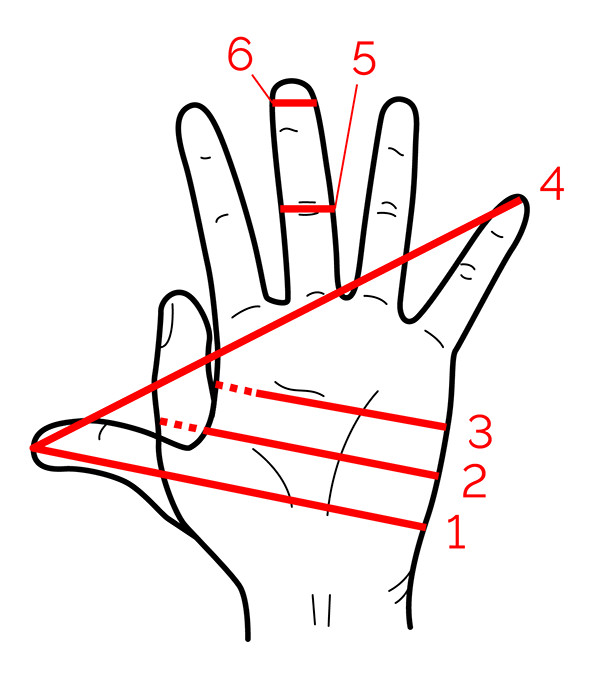
by John Copeland Wednesday, April 11, 2018

Various hand-derived units of measurement. A span, for example, is represented by line 4. Credit: public domain
Have you ever stopped to consider how difficult our lives would be without uniform systems of measurement? Imagine going to the gas station to fill up your vehicle and trying to figure out the volume of gas you’re actually getting. Or buying produce and being unsure if you’re paying the same price per weight as other shoppers. Or having laser eye surgery to correct your vision without knowing whether the laser’s power is accurately known. Whether you use English measurements — the convention in the U.S. — or metric like most of the rest of the world, you’re using a uniform system, and it’s possible to easily translate between one system and another. But it wasn’t always like that.
Ancient measurements of length were based on the human body: the length of a foot, the length of a stride or the span of a hand, for example — all of which are variable units.
About 3000 B.C., a pharaoh established the Egyptian cubit, decreeing it to be the length from the tip of his middle finger to his elbow. Since different people have different lengths of arm, the Egyptians developed a standard royal cubit preserved in the form of a black granite rod. Workers at building sites were given copies in granite or wood, and it was the responsibility of the architects to maintain them. About 1700 B.C., the Babylonians developed their own basic unit of length also called the cubit, which was slightly longer than the Egyptian cubit. The Greeks used the width of a finger as their basic unit of length. The Romans used the foot, which was divided into 12 inches, as their basic unit. Longer measurements were derived from soldiers on the march. Five feet equaled one pace, and 1,000 paces measured a Roman mile, which is reasonably close to the American mile used today.
As the Roman Empire spread, its measurement system was adopted throughout much of Europe. The only problem with invaders dictating standards of measure was that many places were repeatedly invaded by one group and then another, each of which brought their own standard units of measure. In England, for example, Anglos, Saxons, Jutes and Danes brought measures such as the perch, the rod, the furlong and the fathom. Finally, in the early 13th century, England issued a royal ordinance called “Assize of Weights and Measures” that defined a long list of measurements to be used across the land. It was an extremely successful attempt at standardization; its definitions lasted for nearly 600 years.
In France, there was no standardization until the French Revolution. In 1798, the National Assembly adopted a proposal that a new measurement system be based on a length from nature, and should have decimal subdivisions. All measures of area, volume, weight and so on were to be linked to this fundamental unit of length. This was the meter.
The proposal was designed to create an international system of measurement. However, continued tumult in France prevented this from happening until decades later. In the 1870s, scientists from around the world were invited to a conference in Paris, the aim of which was to improve international scientific cooperation by applying the metric system as the worldwide standard. The outcome of the conference was the establishment of the International Bureau of Weights and Measures, housed in Paris, and the Convention of the Meter of 1875, also known as the Meter Treaty, which was signed on May 20, 1875, by representatives of 17 nations, including the United States. More countries signed on in the years that followed.
Today, we honor the treaty that established the first uniform, worldwide system of measurement by celebrating World Metrology Day on May 20. Metrology is the science of measurement, and it plays a central role in scientific discovery and innovation, industrial manufacturing, international trade, and our daily lives.
Today, only the United States, Liberia and Myanmar do not use the metric system as the predominant system of measurement. However, as metric is the sole measurement language of most of the world, foreign customers buying American products are gradually requiring that such products be labeled and produced in metric units; eventually, the United States may finally become a metric nation.
Making quality-assured measurements is an expertise in its own right, and must be carried out in ways such that everyone can have full confidence in the results. This May 20, I suggest stopping to appreciate the many decisions in your life that are based on uniform and accurate measurements..
© 2008-2021. All rights reserved. Any copying, redistribution or retransmission of any of the contents of this service without the expressed written permission of the American Geosciences Institute is expressly prohibited. Click here for all copyright requests.